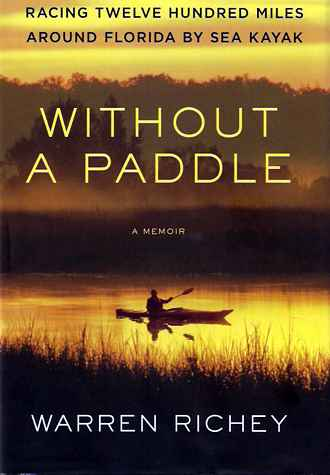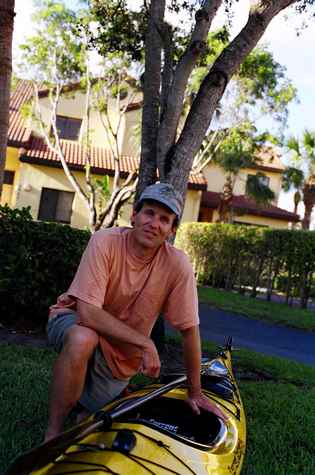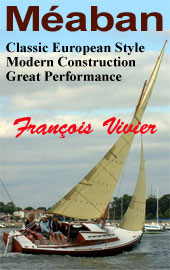| Without a Paddle:
Racing Twelve Hundred Miles Around Florida by Sea Kayak by Warren
Richey
Buy it. Read it. You’ll like it.

Hardcover: 352 pages
Publisher: St. Martin's Press (June 8, 2010)
Language: English
ISBN-10: 031263076X
ISBN-13: 978-0312630768
Dimensions: 8.2 x 5.7 x 1.3 inches
That’s the short review of Warren Richey’s
just-published book, Without
a Paddle. It’s tempting to leave it right there,
not to say anything else. But the proprietor of this fine website
usually demands something more. Besides, he might cut my salary
(I get one 3/4-inch, stainless #6 wood screw per word) for such
a truncated review. And I’ve got a lot of gunwale to attach
to the new boat . . .
So let’s press on and say that Richey’s book has the
elements of an excellent read: a good story to tell and a story
that’s well told. The setting is the first Ultimate Florida
Challenge in 2006. Regular Duckworks readers are probably familiar
with WaterTribe’s annual Everglades Challenge, a 300-mile
annual expedition event that goes south from Tampa Bay around
the tip of Florida and ends in Key Largo.
In 2006, the organization offered an expanded version, 1,200 miles
around the north-south peninsula of Florida. It starts with the
Everglades Challenge. Then from Key Largo, it goes up the entire
east coast of Florida and then treks up the St. Mary’s River.
Then there’s a 40-mile overland portage to the Suwanee and
a twisty-turny down river course back to the Gulf of Mexico and
a stop at Cedar Key. It finishes with a relatively short "dash"
of 120 miles back to the starting line. (The second UFC was run
earlier this year, and the next one will be in 2012.)

Ten hardy souls signed up for the first UFC, including Richey,
a veteran of several ECs.
Without a Paddle puts you with Richey in the cockpit of his sea
kayak as he muscles his way around the state. With frequent humor
and vivid prose, he shares storms and good weather, heat and cold,
his affection and respect for his competitors, and triumphs and
fears. (His fears frequently center on encountering some creature
– alligator, shark, python – that can remind him he’s
in their territory and not the top of the food chain; my fears
usually focus on flipping my sailboat and not being able to right
it.)
Why did he do it? Let the author explain: "Some
time ago, having arrived at the middle years of my life with little
to show for it but a thriving bald spot and a flatulent seventeen-year-old
Toyota, I decided to do something completely nuts. I entered a
race. It was a fiftieth-birthday present to myself, one of those
well-intentioned but somewhat desperate attempts to stir things
up a bit, to get the blood flowing again."
It was more than a physical challenge. Richey had
undergone upheaval in his domestic life and was attempting to
piece it back together. The book successfully splices together
the race, personal thoughts, and snippets of his professional
career (he’s a journalist with extensive foreign experience).
For the nautically addicted, there’s a wealth of detail.
Richey’s days usually consisted of 16 to 18 hours of paddling,
sometimes longer. Readers get to share his observations of the
changing landscape, the satisfaction of sending his craft efficiently
gliding along, and the frustration of slogging against wind, current,
or both. And you’ll almost taste, after several days of
gulped boat food, the ecstasy of a Hostess cherry pie from a convenience
store along the route. Sleep deprivation is a constant companion
and the author is blunt about how it affected his performance
and judgment. Anyone who has done an endurance event like an Everglades
Challenge or the Ultimate Florida Challenge and pushed the limits
will be nodding in recognition.
Hard-core paddlers will benefit from an appendix that lists all
the gear and supplies Richey carried; it’s hard to conceive
anyone coming up with a more efficient compendium.
It’s also hard to come up with the right words to praise
this superlative account. So let’s just settle for saying
it’s well worth the read. I actually read it twice. The
first time, like Richey with his treasured cherry pie, was in
measured bites to prolong the tangy enjoyment. The second time,
after Helen had devoured it, it was consumed in larger chunks.
Without a Paddle is available in bookstores and from Amazon.com.
I got my copy at Borders.
Interestingly, it wasn’t placed in the sporting section
with other books on sailing and kayaking. Instead, it was back
in the biography and autobiography section. I had to go back a
second time and then a friendly clerk had to fetch it from shipping
boxes in the back. Well worth the effort.

|



